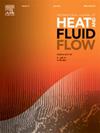喷嘴几何形状和工作方式对连续非定常射流推进性能的影响
IF 2.6
3区 工程技术
Q2 ENGINEERING, MECHANICAL
International Journal of Heat and Fluid Flow
Pub Date : 2025-07-22
DOI:10.1016/j.ijheatfluidflow.2025.109986
引用次数: 0
摘要
本文通过实验研究了喷嘴几何形状、形成时间和占空比对连续非定常射流推进性能的影响。总共考虑了7种不同型腔形状和喷嘴唇角的喷嘴,可分为直管、收缩管和膨胀管。得到了连续非定常射流在不同工作模式下的输出推力和输入功率。在实验数据的基础上,采用功率推力比来评价连续非定常射流的能量转换效率。结果表明:连续非定常射流的节能效果与平均射流雷诺数呈正相关,在较短的形成时间和占空比下具有较高的工作效率。进一步证明了小的喷嘴唇角有利于非定常射流的节能。从能量优化角度分析,在不同的喷管中,双曲型喷管在编队时间3.03、占空比0.4时的推进性能最优。此时,功率推力比为0.018瓦每牛顿。维托辛斯基喷嘴在2.82形成时间下工作,具有最宽的占空比范围,可实现高效运行。本文章由计算机程序翻译,如有差异,请以英文原文为准。

The influence of nozzle geometries and operating modes on the propulsive performance of continuous unsteady jet
In this paper, the effects of the nozzle geometry, formation time and duty cycle on the propulsive performance of continuous unsteady jets were experimentally investigated. Total of seven types of nozzles with different specific cavity shapes and nozzle lip angles were considered, which can be categorized into straight, contracting and expanding nozzles. The output thrust and input power of continuous unsteady jets in different modes of operation are obtained. Based on the experiment data, the power–thrust ratio was used to evaluate the energy conversion efficiency of continuous unsteady jets. The results indicate that the energy saving effect is positively correlated to the mean jet Reynolds number, which the continuous unsteady jet can have high efficiency in the operating mode with small formation time and duty cycle. Furthermore, it is proved that the small nozzle lip angle is conducive to the energy saving of unsteady jets. Analyzed from energy-optimal perspective, among the different nozzles, the hyperbolic nozzle has optimal propulsive performance under the formation time 3.03 and duty cycle 0.4. At this time, the power–thrust ratio is 0.018 watts per newton. The Vitosinski nozzle works under the formation time 2.82 has the widest duty cycle range for high efficiency operation.
求助全文
通过发布文献求助,成功后即可免费获取论文全文。
去求助
来源期刊

International Journal of Heat and Fluid Flow
工程技术-工程:机械
CiteScore
5.00
自引率
7.70%
发文量
131
审稿时长
33 days
期刊介绍:
The International Journal of Heat and Fluid Flow welcomes high-quality original contributions on experimental, computational, and physical aspects of convective heat transfer and fluid dynamics relevant to engineering or the environment, including multiphase and microscale flows.
Papers reporting the application of these disciplines to design and development, with emphasis on new technological fields, are also welcomed. Some of these new fields include microscale electronic and mechanical systems; medical and biological systems; and thermal and flow control in both the internal and external environment.
 求助内容:
求助内容: 应助结果提醒方式:
应助结果提醒方式:


